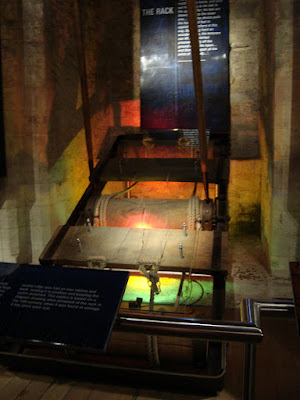Upon waking up on Saturday after an uneasy night and greeted by a sour throat in the morning, my travel mates headed off to what proved to be a day within the pages of history. One thing that I do admire about London is how central most of the famous locations are. If you look on the map, a majority of the most famous structures is located within the center of London along the Thames. With the exception of the British Museum, most of them are close to the river itself, which signifies the importance of that body of water within British history and culture. Yet I digress, on to the sights!
Our first historical stop of the day: the Tower of London. Contrary to popular opinion, and my misconception due to many a British historical documentaries/movies, the Tower of London is not only one tower (a la Rapunzel) but rather, it's an estate that has been occupied by many a British rulers and subjects. It's built in the shape of a square with the White Tower (not like the "Lord of the Rings") occupying the center.
After paying the 12 pound student rate to enter such a noble establishment, we proceeded to make our way around the tower. Starting from the Medieval Palace, once occupied by Edward I and where he sought refuge for a time.
Then, we proceeded to move around the establishment with such sights as:
The White Tower, built by William the Conqueror in 1100AD and currently houses the armor of kings and knights who defended the tower.
Yet, the most interesting part, the reason why I was so eager to visit such a gloomy place, was the infamous Beauchamp tower. This was where Anne Bolyn, Guy Fawkes, Jane Grey, and particularly Elizabeth I was imprisoned. Funnily enough, it was not located in the center of the Tower but rather, to the side.
It always looked so much taller in film...
What I noticed that was most interesting was the shape of the windows looking out.
Is it a mocking gesture or was it used to convey a sense of false hope and perhaps even piety? Amazing the power of religion.
Finally, there was the most chilling part of all: the torture tower. Of course, it is nameless (as well it should be) and the entrance to it differs from the other entrances in that you are led downward into the chamber rather than up spiraling staircases. It is there that I could feel the ghosts of so many years and looking at the model of the torture devices employed on prisoners, I was made aware of the sadistic nature of humanity, and how dark we have gone.
What kind of person could invent such a punishment? And who could actually use it on someone? What does it say about humanity that such a device exists?
Walking through the steps and halls that span hundreds of years, where people such as Elizabeth and William Raleigh were imprisoned, where countless others were tortured, the same steps that so many kings and prisoners once walked, I was quickly struck by an otherworldly sense of disorientation. From the etching on certain walls within the building, the history just seemed to permeate the entire structure, an uncanny sense of lost souls and supreme acts of human cruelty. I was particularly struck by how new and clean the walls of the entire structure still looked (albeit some places were in a state of renovation and were blocked off). It was as if the entire castle had been suspended in time and we were just travelers from another world. We didn't seem to belong to the structure.
Following this excursion through time was a short Underground ride north of the Thames to the British Museum, a large, dominating, wonderful piece of a building. And the best part about it? It's free! For the budget traveler, the best places to go when in London are museums because not only do you not have to pay to enter (save for viewing new exhibitions), but you are privy to such a large reservoir of history, culture, and really incredibly sights.
There, we spent two hours rushing through everything, trying to take it all in. In our rush, we saw:
The Elgin Marbles, the pieces of Grecian history that sparked a war of controversy over their proper owners. Lets leave that legal bit aside and just admire the thousands of years old craftsmanship.
Mummies. Lots and lots of mummies...
Roman artifacts, such as this gladiator helmet. Imagine Russell Crow wearing it.
And believe or not, that took us two hours so as you can see, we barely grazed the surface. I feel like even if I had a day to spend, I would still not uncover all this museum has to offer. There's so much to see and not enough time to do so, which is frustrating. Yet, it is also amazing how much information and history is encased within this one space and how lucky we are to be able to still see such historical relics and monuments, that they haven't all been lost.
After the two hours, brains partially fried, we decided (after stopping quickly at Oxford Circus to buy one our compatriots a new pair of shoes) that it was dinnertime. And what better way to end our day of history than to go to an old-fashioned, English pub.
Located on Fleet Street (beware the demon barbers), the Ye Olde Cheshire Cheese had been around since 1538 and was rebuilt in 1666 after the Great Fire destroyed the old building. This pub, located within an nondescript alleyway on Fleet Street, has seen such famous writers as Charles Dickens, Mark Twain, Alfred Tennyson, and apparently Ben Jonson. The interior belies its age with its wood paneling, low staircases, cellars (there was a bar down there), and dim lighting. And the food wasn't too shabby either.
After dinner was a long, cold walk, back to the nearest tube station where on the way, we passed by Saint Peters. Most of us were cold, tired, and sore yet it was the perfect ending to a day of wandering through the pages of history.














No comments:
Post a Comment